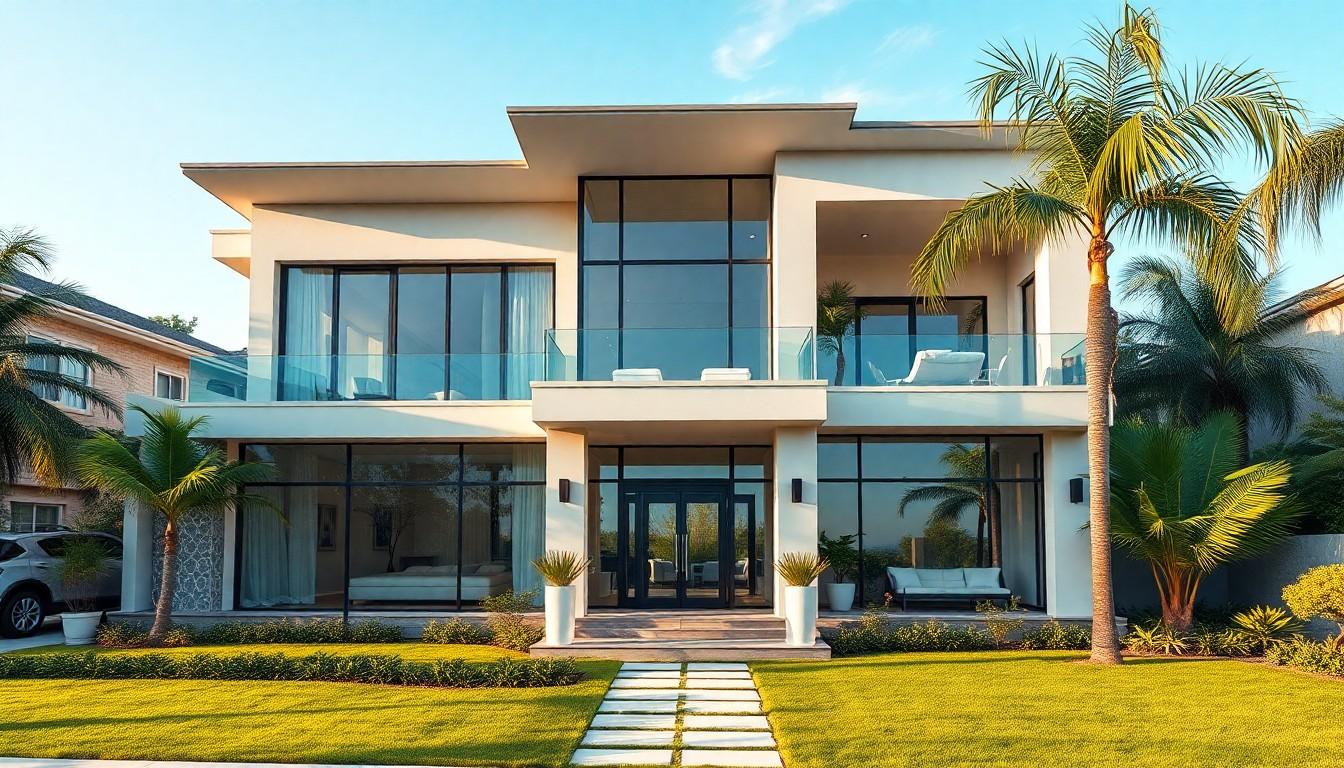Physical Address
304 North Cardinal St.
Dorchester Center, MA 02124

The luxury real estate market isn’t just about opulent mansions and breathtaking views; it’s a dynamic playground where trends shift faster than a high-end sports car on a racetrack. As buyers become more discerning, the market adapts, showcasing properties that cater to their every whim and desire. From smart home technology to eco-friendly designs, the latest trends are turning heads and opening wallets.
The luxury real estate market shows dynamic growth influenced by diverse factors. Buyers increasingly prioritize smart home technology, which enhances convenience and security. Eco-friendly designs attract attention, with many buyers seeking sustainable living options. Market demand reflects a shift towards personalization, where custom features and unique interior designs drive purchases.
Urban areas remain popular, though suburban luxury homes experience heightened interest due to changing lifestyles. Coastal properties also maintain a strong appeal, with individuals valuing access to waterfront views and leisure activities. Investment in second homes continues, particularly in sought-after vacation destinations, as remote work enables greater flexibility.
Pricing strategies have evolved, reflecting market conditions. Sellers are more likely to adjust prices to capture interest from discerning buyers. Staging luxury homes with an emphasis on lifestyle can provide a competitive edge, making properties more appealing. International buyers contribute significantly, with affluent individuals from various countries pursuing opportunities in the U.S. market.
Current data supports these trends, highlighting that luxury home sales increased by 10% in the last year in major metropolitan areas. This statistic signifies growing confidence among high-net-worth individuals seeking real estate investments. Overall, the landscape of luxury real estate continues to adapt, responding to buyer preferences while maintaining an allure that resonates with affluent lifestyles.

Several factors shape the dynamics of the luxury real estate market. Understanding these influences can help identify future trends.
Economic growth significantly impacts luxury real estate demand. Record stock market performance has created wealth among high-net-worth individuals. Low-interest rates encourage investment in high-value properties, reinforcing the desire for luxury. Additionally, the ongoing recovery from past economic downturns strengthens buyer confidence. Access to financing remains favorable for affluent buyers, further driving the purchase of luxury homes. Reports indicate a 10% increase in luxury home sales, attributing this growth to a robust economy and investor enthusiasm.
Demographic shifts affect luxury real estate preferences. Millennials and Gen Z are entering the luxury market, prioritizing experiences over possessions. This younger demographic values sustainable living, prompting increased interest in eco-friendly homes. Additionally, older generations, particularly Baby Boomers, look to downsize while maintaining luxurious lifestyles. A desire for multi-generational living also shapes demand, emphasizing spacious layouts and community amenities. Statistics reveal that 57% of luxury homebuyers consider community features essential when making purchasing decisions, highlighting the impact of demographic trends on luxury real estate.
Understanding regional trends provides valuable context in the luxury real estate market. Each region showcases unique characteristics and buyer tendencies.
North America experiences a robust luxury real estate market, marked by high demand in metropolitan areas. Major cities like New York and Los Angeles see a 10% increase in luxury home sales annually, reflecting strong buyer confidence. Suburban areas are gaining traction as buyers seek spacious homes and access to outdoor amenities. Interest in second homes in regions like Aspen and Miami is rising, driven by remote work flexibility. Eco-conscious designs and smart home innovations capture buyers’ attention. Buyers in this region prioritize lifestyle features, making customization essential for market success.
Europe’s luxury real estate landscape is diverse, with varying trends across countries. Cities like London and Paris attract affluent buyers seeking urban living with cultural vibrancy. The demand for eco-friendly properties grows, with many buyers valuing sustainability alongside luxury. Coastal locations, particularly in Spain and Italy, remain desirable for those seeking leisure. Data indicates that wealthy individuals increasingly invest in European properties as a safe haven in uncertain times. Investments in luxury real estate are becoming more personalized, emphasizing unique architectural styles. Buyers are also drawn to historical and character-rich homes, reflecting a blend of tradition and modernity.
Asia-Pacific witnesses dynamic shifts in luxury real estate, driven by rising affluence in markets like China and Australia. Urban centers such as Hong Kong and Sydney see escalating demand, often marked by limited supply. Interest in luxury condominiums and waterfront properties is particularly strong. The trend of investing in second homes in vacation destinations gains momentum, with locations in Bali and Phuket leading the way. Young affluent buyers increasingly prioritize sustainability and technological advancements. Developers respond with eco-friendly designs and smart technology integration to meet these rising expectations. Overall, the region’s luxury market is characterized by adaptability and innovation.
The luxury real estate market reflects evolving buyer preferences, emphasizing sustainability and technology integration. These two aspects increasingly define modern luxury living.
Sustainable building practices gain traction among luxury buyers. Eco-friendly materials and energy-efficient designs not only reduce environmental impact but also align with the values of discerning clients. Properties featuring solar panels, rainwater harvesting systems, and sustainable landscaping attract buyers seeking greener lifestyles. Notably, a growing preference for properties in eco-conscious communities highlights a shift toward sustainable living. Emphasis on wellness-focused designs and amenities, including air purification systems and natural lighting, further enhances appeal. With climate awareness on the rise, luxury properties that prioritize sustainability stand out in a competitive market.
Smart home technology reshapes luxury property expectations. Automation features like advanced security systems, smart lighting, and climate control attract tech-savvy buyers. Homes equipped with integrated smart home platforms offer seamless control, enhancing convenience and lifestyle. Buyers appreciate systems allowing remote access and monitoring, which adds a layer of safety and comfort. Enhanced connectivity, such as high-speed internet and IoT capabilities, becomes essential in luxury homes. Additionally, properties that integrate smart technology with versatile designs showcase modern functionality while catering to upscale living demands. Data reveals that luxury homes with such innovations experience heightened interest and value in today’s market.
Navigating the luxury real estate market involves several challenges that impact buyers and sellers alike. Market volatility remains a significant concern. Fluctuations in the stock market and economic shifts can create uncertainty for high-net-worth individuals. Buyers often hesitate to commit to investments during unstable periods, affecting overall sales. Luxury properties, while generally resilient, still feel the impact of sudden price adjustments and changing buyer sentiment.
Regulatory changes contribute another layer of complexity. New policies can emerge rapidly, influencing foreign investments and property ownership. Tax implications significantly affect purchasing decisions, especially for international buyers keen on U.S. markets. Understanding local zoning laws often proves challenging for affluent investors seeking to develop or renovate properties. Compliance with evolving environmental regulations also demands attention, as buyers increasingly prioritize sustainability in luxury living. Being aware of these regulatory dynamics is crucial for navigating the luxury real estate landscape.
The luxury real estate market is undeniably shifting to meet the demands of a new generation of buyers. With a focus on sustainability and technology, properties that prioritize eco-friendly designs and smart home features are becoming increasingly desirable. As buyers seek personalization and unique experiences, the market adapts to these evolving preferences.
The rise in interest for suburban homes and second properties reflects changing lifestyles and work flexibility. Despite the challenges posed by market volatility and regulatory changes, high-net-worth individuals remain optimistic about investing in luxury real estate. As the landscape continues to evolve, staying informed about these trends will be crucial for both buyers and sellers navigating this dynamic market.